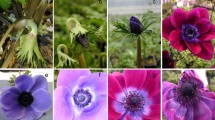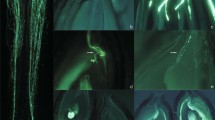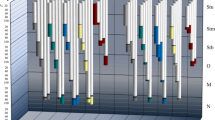Summary
Comparative studies on self-pollination after the application of high concentrations of CO2 gas, which is known to overcome the self-incompatibility reaction in Cruciferous species, have revealed significant changes in the pollen tubes of germinating grains prior to their penetration into the papilla cells. A remarkable increase in the width of the pollen tube was induced by treating the stigmatic papillae with high CO2 concentrations. The width of the pollen tube appeared to be greatest with CO2 concentrations ranging from 3% to 5%; these concentrations were also optimal for tube penetration. Callose accumulation was extensively induced in the stigmatic papilla with 10%–20% of CO2, although a typical callosic reaction remained through the ranges appropriate for blocking self-incompatibility. Observations using the scanning electron microscope (SEM) after pollination revealed that compatible pollen tubes in cross-pollinations fused completely to the papular surface during tube penetration, while in self-pollination, pollen tubes remained on the papilla with some additional diffusate. In the case of CO2 treatment for self-pollination, some pollen tubes behaved very similarly to the incompatible or compatible ones already described, while others were different from both of them: they showed a complete fusion, similar to compatible ones, with additional diffusate, similar to incompatible ones. These responses of the pollen and stigma to high CO2 concentrations are discussed with respect to their effect upon the expression of self-incompatibility.
Similar content being viewed by others
References
Carter AL, Williams ST, McNeilly T (1975) Scanning electron microscope studies of pollen behaviour on immature and mature Brussels sprouts (Brassica oleracea var. ‘gemmifera’) stigmas. Euphytica 24:133–141
Dhaliwal AS, Malik CP, Singh MB (1981) Overcoming incompatibility in Brassica campestris L. by carbon dioxide, and dark fixation of the gas by self- and cross-pollinated pistils. Ann Bot (London) 48:227–233
Dickinson HG, Lewis D (1973) Cytochemical and ultrastructural differences between intraspecific compatible and incompatibile pollinations in Raphanus. Proc R Soc London Ser B 183:21–38
Heslop-Harrison J (1975) Incompatibility and the pollen-stigma interraction. Annu Rev Plant Physiol 26:403–425
Kerhoas C, Knox RB, Dumas C (1983) Specificity of the callose response in stigmas of Brassica. Ann Bot (London) 52:597–602
Nakanishi T, Hinata K (1973) An effective time for CO2 gas treatment in overcoming self-incompatibility in Brassica. Plant Cell Physiol 14:873–879
Nakanishi T, Hinata K (1975) Self-seed production by CO2 gas treatment in self-incompatible cabbage. Euphytica 24:117–120
Nakanishi T, Esashi Y, Hinata K (1969) Control of self-incompatibility by CO2 gas in Brassica. Plant Cell Physiol 10:925–927
Ockendon DJ (1972) Pollen tube growth and the site of the incompatibility reaction in Brassica oleracea. New Phytol 71:519–522
O'Neill P, Singh MB, Neales TF, Knox RB, Williams EG (1984) Carbon dioxide blocks the stigma callose response following incompatible pollinations in Brassica. Plant Cell Environ 7:285–288
Palloix A, Herve Y, Knox RB, Dumas C (1985) Effect of carbon dioxide and relative humidity of self-incompatibility in cauliflower, Brassica oleracea. Theor Appl Genet 70:628–633
Roberts IN, Gaude TC, Harrod G, Dickinson HG (1983) Pollen-stigma interactions in Brassica oleracea; a new pollen germination medium and its use in elucidating the mechanism of self-incompatibility. Theor Appl Genet 65:231–238
Roggen HPJR (1972) Scanning electron microscopical observations on compatible and incompatible pollen-stigma interactions in Brassica. Euphytica 21:1–10
Sfakiotakis EM, Simons DH, Dilley DR (1972) Pollen germination and tube growth: dependent on carbon dioxide and independent of ethylene. Plant Physiol 49:963–967
Stanley RG, Search RW (1975) Pollen protein diffusates. In: Heslop-Harrison J (ed) Pollen; development and physiology. Butterworths, London, pp 174–176
Stanley RG, Young LCT, Graham JSD (1958) Carbon dioxide fixation in germination in pine pollen (Pinus ponderosa). Nature 182:1462–1463
Stead AD, Roberts IN, Dickinson HG (1979) Pollen pistil interaction in Brassica oleracea; events prior to pollen germination. Planta 146:211–216
Taylor JP (1982) Carbon dioxide treatment as an effective aid to the production of selfed seed in kale and Brussels sprouts. Euphytica 31:957–964
Thomas MK, Dnyansagar VR (1975) Carbohydrate metabolism in pollen of Petunia nyctagniflora Juss during germination and tube growth. Indian J Exp Biol 13:268–271
Author information
Authors and Affiliations
Rights and permissions
About this article
Cite this article
Nakanishi, T., Sawano, M. Changes in pollen tube behaviour induced by carbon dioxide and their role in overcoming self-incompatibility in Brassica . Sexual Plant Reprod 2, 109–115 (1989). https://doi.org/10.1007/BF00191999
Issue Date:
DOI: https://doi.org/10.1007/BF00191999




